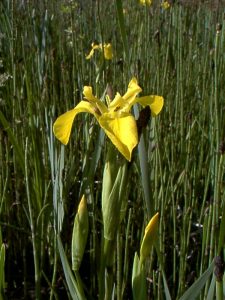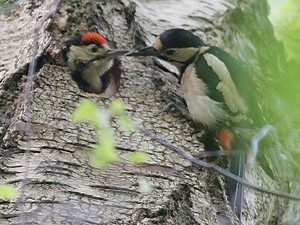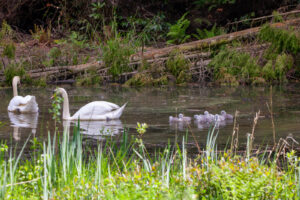The rhododendron is pretty spectacular at this time of year along with the yellow azaleas which flower along the lake path. The flag iris is turning the marsh from green to gold. Summer flowers are at their best this month. Heath and common spotted orchids are out in profusion along with bugle, tormentil, red campion, foxgloves, honeysuckle and ragged robin. The wildflower blooms so far, along with the hawthorn, blackthorn and various fruit blossoms, have been remarkably profuse. After last year’s heat waves and the stress that caused to the plants and trees, they’re concentrating on seed production to ensure the survival of future generations in case the same happens again this year. 2023 will see a bountiful autumn for fruits, berries and nuts !

June is the month when thousands of tits fledge countrywide. The bushes and trees around the Park are full of young tits, nuthatches and wrens which will stay in their family groups. Swallow and house martin young hatch this month and the first of the young sand martins on the River Teign are due to fledge from their colonial burrows. Some of the older birds will manage to go on to rear a further two broods. The swifts have arrived, following behind the swallows and martins, and are the first to leave in August. Keep an eye out for nightjars in the evenings which arrived from Africa during the first half of May. Spotted flycatchers also migrate and come from central Africa in May. They can be seen sitting on a perch from which they watch for flying insects, periodically darting out to catch them. The great-spotted woodpeckers have been filling Stover with the sound of their drumming. The young have now hatched out and can be heard calling to the adults. Three tawny owlets were spotted in the arboretum – they are usually hard to spot with their camouflaged down. Regular sightings of bullfinch and stock doves occurred during last month. The stock doves can be seen at the aerial walkway and are slightly smaller than wood pigeons, lacking their white neck and wing markings. Stock doves are shy birds and usually are not found where humans habituate. Keep an eye out for hobbies feeding over the lake and marsh. They spend the winter in Africa, arriving in Britain in late April and May to breed.

Fewer wildfowl will be on the wing this month because now is the time that they replace all their old flight feathers. For most breeding ducks, geese and swans this moult happens when they are rearing their flightless chicks. Some ducks, coots and moorhens are still sitting on eggs. Several broods of ducklings, coot and moorhen can be seen on the lake – the first broods are now nearly fully grown. The swans’ eggs hatched on 6th May (2 days earlier than last year) with 9 cygnets again for the third year running. Thankfully this year all 9 have survived so far. There were no sightings of common sandpipers during May which was unusual. Their long bills are used for probing in the mud beside water for worms, insects and frogs. The great-crested grebes have been late breeding this year and are now on their third nest – fingers crossed they don’t abandon this latest one. Two male shovelor were recorded on 21st May just for the day, joining what appears to have become Stover’s resident male tufted duck; it mustn’t have fancied migrating back in March with the others to northern Scandinavia and Russia to breed.

by Joanna Humphrey
Bats are active at this time of year and can be seen on most evenings skimming over the lake feeding on moths and midges. They will give birth to their single young this month. The May bat box checks recorded Soprano pipistrelles, long-eared and Natterers bats. Young hedgehogs are born in early June with badger and fox cubs starting to wander further afield. Roe deer young are born this month and lie hidden in the undergrowth. The summer months (May to August) is the peak time for the birth of otter cubs and the females are kept busy caring for their young families.
Keep an eye out for the young frogs and toads which will begin to leave the ponds and ditches in June. Newts will also be returning to land to feed after they have bred. They spend much of the day amongst the damp vegetation and under logs and stones. Both terrapins, red-eared and smooth shelled, have been spotted in the lake on several occasions following their winter’s hibernation.
The elder trees are just starting to flower – the flowers provide landing pads for hoverflies, wasps and beetles. Stag beetles are just one of the many types of beetle that emerge in June. Keep an eye out for glow-worms which will light up at dusk in rough grass. They tend to prefer areas where there are plenty of small snails, as this is what their larvae feed on.
Many butterflies and dragonflies are now on the wing enjoying the sunny weather. On the butterfly front the first holly blue was spotted on 3rd May, red admiral on 12th May, with the first speckled wood on the 26th. Brimstones were busy laying eggs on the alder buckthorn at the end of last month. Speckled woods should now be onto their second generation of the year.
The dragonflies are getting more noticeable. Joining the large red damselflies, the only species seen in April, are common blue, azure, blue-tailed, red-eyed, and beautiful demoiselle damselflies; and hairy, downy emerald, broad-bodied chaser, four-spotted chaser, and emperor dragonflies. A very early common darter put in an appearance on 14th May. They are usually not seen until the end of May at the earliest. Keep an eye out for black-tailed skimmers as they have usually been seen by now.